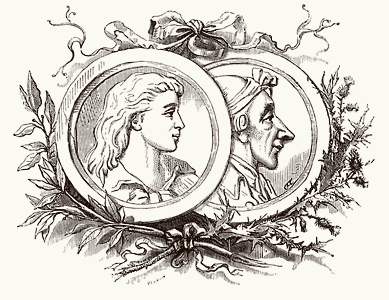
The Adventures of Robert-Robert and of his faithful companion Toussaint Lavenette (Les Aventures de Robert-Robert et de son fidèle compagnon Toussaint Lavenette) was written by Louis Desnoyers (1802-1868) and published, as it seems, in 1839. The first edition consisted of two volumes, containing illustrations drawn by Frédéric de Courcy and engraved in wood by Bisson. The pictures available on this site are taken from the ninth edition, published after 1860, which counts only one volume, in quarto format (16×25 cm; 6.3×9.4 inches). The spine of the half-binding is decorated with false bands and covered with dark blue sheepskin, the boards with blue and orange marble-like paper. Forewords are paginated from I to XII and the rest of the book from 1 to 527. All illustrations are plates, except for the above vignette.
The story is about a young teenager and his mentor and sidekick Lavenette, and the many adventures they go through on their way to the Bourbon island, where …Read more »
Tags: Adventures of Robert-Robert, Book descriptions, childrens literature, fiction, nineteenth century, novel

The “Nouveau dictionnaire encyclopédique universel illustré“, to give it its full and original name, was published in Paris between 1886 and 1891, under the direction of Jules Trousset. It is said to be complete in six volumes, although a seventh one was released later as an update. The sixth volume is made of maps and charts. These books are in quarto format, approximately 25×35 cm and contain some 800 pages each, except for the smaller sixth one.
Typically following the eighteenth century humanist tradition, which saw the edition of the encyclopedia by Diderot and d’Alembert, it combines lexicographical endeavour with extended information on technical subjects. A particular emphasis was placed on chemistry and electricity, which were at the time fields of recent discoveries, as well as on legal matters. It contains numerous illustrations (over 3000) and in this area, the publishers certainly seem to have pulled all the strings : the wood engravings could be made from photographs as well as from other engravings, taken from technical books, or even encyclopedias published in France or abroad. Very few, if any, must have been made from original designs.
It is easy to imagine, behind this wealth of illustrations, one or more semi-industrial engraving workshops, such as the one kept by the magazine “L’Illustration”, where images where produced around the clock.
Wood engraving was at the time a popular reproduction technique, used in mass publication. The paper …Read more »
Tags: Book descriptions, nineteenth century, Trousset encyclopedia




